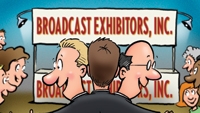So little time, so many stands
After IBC2006, many people asked, “What did you see? What sparked interest?” I got to thinking that two people could go to IBC or NAB and never meet. They would each have an entirely different take on the show.
The problem is that the shows attempt to be all things to all people and to have something for everyone. You may be a transmitter guy, or perhaps you're looking for camera support. By their very nature, the shows are too large if you want to see everything.
The newcomer to shows may suggest that they should last longer. After all, many consumer shows last for 10 days. But they are different; the attendees rarely visit more than one day, and the booths are often manned in shifts.

Few vendors at IBC could spare their valuable staff out of the office for 10 days. Imagine the impact of shutting the sales department for that length of time. Many companies find that the time out for support and development engineers is costly. It is not surprising that major companies occasionally drop out of shows and question their value.
For the attendees, 10 days would be a trial; most of us have had enough after four days. Again, broadcasters and post houses cannot spare senior personnel for more than a few days. It is quite common for folks to attend shows over the weekend so as not to disrupt their business.
That means four or five days is just fine.
People often say to me after the show, “Did you see that new widget?” Or, “Joe Blow gave a really interesting paper.” I have come to the conclusion that if you want to listen to the papers, you would miss all the new products and the networking. So which do you choose? Shows are great places to catch up with old friends; it is the only time I get to meet some folks face-to-face. I can read the technical papers at my leisure, even though they may not have the same impact as listening to the original presenter.
The professional video industry's #1 source for news, trends and product and tech information. Sign up below.
I even get to hear about the new products if the marketing departments are doing their job. But what of the little start-up companies — the ones with the great ideas? Often run by engineers, they don't bother with marketing, so how do you get to hear of them?
This is where the bush telegraph helps. With luck, you bump into a friend who tells you that you must stop by Stand 1234 to see this amazing device that is going to transform TV production.
It is the scale of the shows that creates these issues. IBC had around 1300 stands. That's 260 stands per day if you wanted to visit all of them. Of course, forward planning helps, but that rules out discovery. You can plan to visit what you know, but then how do you discover the unknown? Again, it falls on the heads of the marketing departments. If they don't shout about their products, then it is unlikely we will find them.
It is a common misconception of design engineers that their products are so world-breaking that customers will be breaking down the doors trying to buy them. My advice to start-ups would be to get a marketing director in at the start. Otherwise, you will get lost in the noise. Folks do not aimlessly roam the aisles of IBC and NAB; they have a plan, and a tight one at that. They see what they want to see, hear the presentations that look interesting, and meet up with old friends and discuss the changing times of the television business.
There is just not the luxury of a magical mystery tour.Time is too valuable.
Send comments to:editor@broadcastengineeringworld.com
